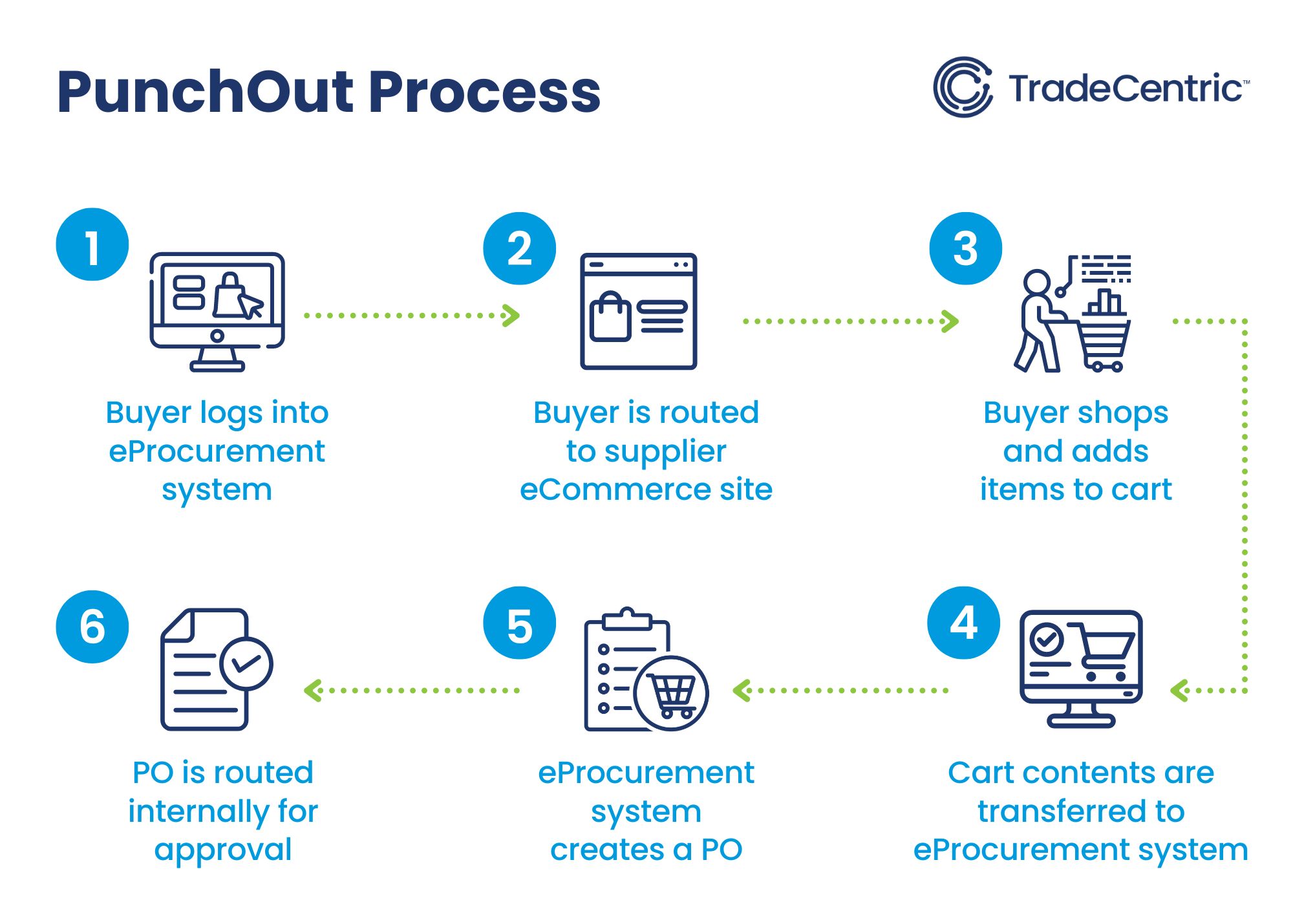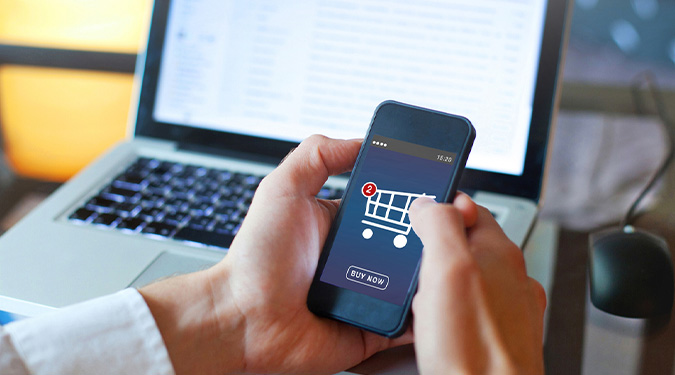Table of Contents
What is a PunchOut Catalog?
A PunchOut catalog is an online B2B eCommerce site that a buyer can access from their own procurement system. PunchOut catalogs connect eProcurement solutions to eCommerce systems, enabling B2B companies to streamline the shopping process by automating authentication and cart order transfer between buyer and supplier systems.
How Does A PunchOut Catalog Work?
PunchOut catalogs require a PunchOut integration between the buyer’s eProcurement system and the supplier’s catalog. Once this connection is achieved, the buying organization can access approved suppliers’ eCommerce websites by logging into their procurement system.
After logging into the procurement application, the buyer searches for and selects an approved supplier (or a product in the case of Level 2 PunchOut catalogs). This initiates a PunchOut setup request in which the buyer’s credentials are immediately validated and authenticated. The buyer is then redirected to the supplier’s store to begin the PunchOut process.
Process Overview: Steps to Complete a PunchOut
- Buyer accesses the eProcurement system and searches or selects an approved supplier’s logo.
- Buyer is routed into the supplier’s eCommerce system to view the correct product offerings, prices and inventory levels.
- Buyer adds the items to their cart.
- When they have finished shopping, instead of checking out, the buyer transfers their cart data from the supplier’s eCommerce system into their eProcurement system.
- The eProcurement system creates a purchase requisition with the transferred cart data.
- The purchase requisition is routed internally for approvals according to the buyer’s procurement policies and approval workflows.

Why Do PunchOut Catalogs Matter?
As the B2B purchasing processes continue to digitize, buyers increasingly prefer suppliers who offer an eCommerce-based sales experience that easily integrates with their eProcurement spend management systems.
To attract new business and retain existing customers, suppliers must offer integrated, automated sales channels that provide a seamless user experience. PunchOut catalogs are the leading eProcurement integration and automation solution to support this type of experience and give suppliers a competitive advantage.
In short, a PunchOut catalog supports more efficient digital trading capabilities for buyers and suppliers alike.
Need a PunchOut Solution?
Benefits of a PunchOut catalog
As we revealed in a recent TradeCentric research report, 82% say B2B eCommerce is their most frequently used digital channel. eProcurement integration and PunchOut catalogs give buyers the fast, automated, self-serve experience they prefer. On the other hand, suppliers can build stronger and longer-lasting customer relationships.
Mutual Benefits of a PunchOut Catalog
PunchOut catalogs leverage data transformation to support two-way communication, translating procurement data and documents in near real-time. The automated two-way data transfer between supplier B2B eCommerce platforms and buyer procurement software eliminates the need to rekey order data manually. As a result, buyers and suppliers can spend less time on manual and error-prone data entry and more time supporting strategic business initiatives.
Supplier Benefits of PunchOut Catalog
Offering a PunchOut catalog enables suppliers to meet buyer requests for eProcurement integration, resulting in wallet share gain and increased revenue from new and existing customers.
Additional benefits of PunchOut-enabled eCommerce include:
- Improved customer experience by offering buying organizations real-time, accurate data on negotiated prices and inventory
- Increased brand recognition and visibility via PunchOut integration
- Broadened customer exposure to new products
- Enhanced order accuracy, which ensures orders are received with valid information to smooth the supplier order fulfillment process
Buyer Benefits of PunchOut Catalog
Buyers adopt modern procurement systems to streamline, centralize and better manage purchasing. PunchOut catalogs allow buyers to take full advantage of their platform’s capabilities while reducing manual rekeying, increasing data transparency and eliminating procurement errors.
The advantages of PunchOut-enabled procurement processes include:
- Reduced transaction costs through automation and simplified workflows
- Improved shopping experience through integrated and personalized eCommerce
- Enhanced productivity for procurement professionals
- Accelerated transaction speed with reduced purchase cycle times
- Reduced rogue spending
WHITEPAPER
Connect eCommerce systems with eProcurement solutions to enable seamless purchasing
Download
PunchOut Catalog Challenges
Introducing new technology into the buying process may seem complicated, but PunchOut catalogs create a streamlined procurement experience that integrates directly with buyers’ eProcurement solutions.
Compatibility and mapping challenges:
cXML is widely used by eProcurement platforms, including Jaggaer and Coupa. SAP platforms primarily use OCI. The majority of modern eProcurement systems use either cXML or OCI.
Although these are standardized data formats, the implementation can differ between platforms, providers, and end-user businesses. These differing implementations often cause compatibility and mapping challenges when buyers and suppliers integrate their software to enable PunchOut catalogs.
Compatibility-related expenses and technical difficulties:
Compatibility issues make integration more expensive and technically difficult. With more than 75 eCommerce systems and more than 150 eProcurement solutions, there are thousands of possible combinations of eProcurement to eCommerce connections.
In the past, integrating buyer and supplier software often required costly custom integrations for each combination, and suppliers were rarely willing to provide PunchOut catalogs to any but their biggest customers.
Steep learning curve to build, manage and scale PunchOut integrations:
Creating PunchOut integrations require heavy reliance on IT, taking resources away from adding value to other areas of the business. Further, these types of integrations typically fall outside of scope for most in-house technical teams due to their complex nature and maintenance requirements.
Once the connections are built, there is often a lack of technical support and testing, which can lead to integration failures. Scaling PunchOut integrations can also present challenges as each unique connection requires its own custom-built integration.
Technical Requirements of a PunchOut Catalog
PunchOut catalogs rely on an integration that enables B2B eCommerce stores and buyer eProcurement solutions to exchange data. Order data and other information is encoded into a data format recognized by both platforms or by an integration layer that mediates communications between the buyer and supplier software. PunchOut catalog data is encrypted and communicated to the proper channels through a secure internet connection.
Data Formats
Two main data formats are in widespread use for PunchOut catalogs:
- cXML is an XML-based protocol and data format developed by Ariba in the late 1990s for the Ariba eProcurement platform. We explored cXML in greater depth in What is cXML?
- OCI is an alternative data format developed by SAP.
cXML and OCI PunchOut catalog integration have several advantages over older procurement integration technologies such as Electronic Data Interchange (EDI 832) and Catalog Interchange Format (CIF) catalogs.
Traditional EDI catalogs relied on peer-to-peer connections between buyer and supplier platforms or on value-added networks, which acted as a hub for communication between multiple businesses. EDI implementation is more complex and expensive than PunchOut catalogs, and it does not support the superior procurement experience offered by B2B eCommerce and PunchOut catalog technology.
CIF catalogs are static hosted files. They may be adequate for small catalogs that rarely need updating. But they are not suitable for larger catalogs or catalogs in which product details such as pricing change frequently. In contrast, PunchOut catalogs are dynamic. Because they are based on eCommerce software, suppliers can dynamically adjust product information and leverage B2B eCommerce features to provide an up-to-date, personalized experience.
Implementing a PunchOut Catalog
Building and maintaining PunchOut integrations in-house can be challenging for B2B businesses, which is why many turn to third-party integration specialists such as TradeCentric. Not only does TradeCentric have dedicated resources to build, maintain and scale PunchOut integrations, but we also have pre-built connectors between leading eCommerce systems and eProcurement applications to get integrations live seamlessly and quickly.
Companies who offer partner with a third-party integration specialist to implement a PunchOut integration:
- Accelerate timeline to successfully completing PunchOut integration
- Reduce resource requirements to maintain integrations with trading partners
- Free up time and resources for IT & operations groups to focus on other value-add tasks for the business
Connected Commerce Solutions That Are Complimentary to PunchOut Catalogs
The basic functionality of our PunchOut catalog solution can be augmented with additional procurement automation features.
Purchase Order (PO) Automation
Purchase Order Automation automatically creates a purchase order on the supplier’s eCommerce store when the order is approved in the buyer’s eProcurement system.
Invoice Automation
Invoice Automation, which translates and automatically delivers supplier invoice data into buyer eProcurement systems to ensure invoice data is properly validated, formatted and ready to be reconciled for payment.
Advanced Shipping Notices
Advanced Shipping Notices contain additional shipment and tracking information in a format that can be automatically accepted into the buyer’s systems.



